Toyota RAV4 (XA40) 2013-2018 Owners Manual: Tires
Replace or rotate tires in accordance with maintenance schedules and treadwear.
Checking tires
- New tread
- Treadwear indicator
- Worn tread
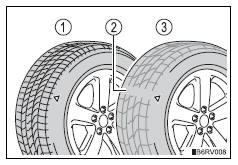
The location of treadwear indicators is shown by the ¢Â§twi¢¸ or ¢Â§ƒ´¢¸ marks, etc., Molded on the sidewall of each tire.
Check spare tire condition and pressure if not rotated.
Tire rotation
Rotate the tires in the order shown.
Vehicles with compact spare tire
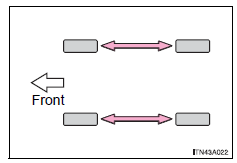
Vehicles with full-size spare tire
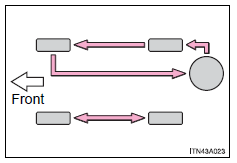
Do not fail to initialize the tire pressure warning system after tire rotation.
To equalize tire wear and extend tire life, toyota recommends that tire rotation is carried out at the same interval as tire inspection.
Tire pressure warning system (if equipped)
Your vehicle is equipped with a tire pressure warning system that uses tire pressure warning valves and transmitters to detect low tire inflation pressure before serious problems arise.
If the tire pressure drops below a predetermined level, the driver is warned by a warning light.
Installing tire pressure warning valves and transmitters
When replacing tires or wheels, tire pressure warning valves and transmitters must also be installed.
When new tire pressure warning valves and transmitters are installed, new id codes must be registered in the tire pressure warning computer and the tire pressure warning system must be initialized. Have tire pressure warning valve and transmitter id codes registered by your toyota dealer.
Initializing the tire pressure warning system
The tire pressure warning system must be initialized when changing the tire size:
When the tire pressure warning system is initialized, the current tire inflation pressure is set as the benchmark pressure.
How to initialize the tire pressure warning system
- Park the vehicle in a safe place and turn the engine switch to the
“lock” position (vehicles without a smart key system) or off
(vehicles with a smart key system).
Initialization cannot be performed while the vehicle is moving.
- Adjust the tire inflation pressure to the specified cold tire inflation pressure level. Make sure to adjust the tire pressure to the specified cold tire inflation pressure level. The tire pressure warning system will operate based on this pressure level.
- Turn the engine switch to the “on” position (vehicles without a smart key system) or ignition on mode (vehicles with a smart key system).
- Press and hold the tire pressure warning reset switch until the tire pressure warning light blinks slowly 3 times.
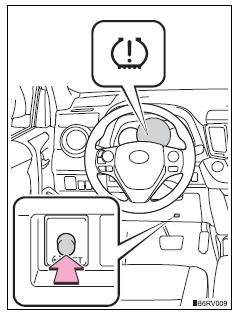
- Vehicles without a smart key system: wait for a few minutes with
the engine switch in the “on” position and then turn the engine
switch to the “acc” or “lock” position.
Vehicles with a smart key system: wait for a few minutes with the engine switch in ignition on mode and then turn the engine switch off.
Registering id codes
The tire pressure warning valve and transmitter is equipped with a unique id code. When replacing a tire pressure warning valve and transmitter, it is necessary to register the id code. Have the id code registered by your toyota dealer.
When to replace your vehicle’s tires
Tires should be replaced if:
- You have tire damage such as cuts, splits, cracks deep enough to expose the fabric, and bulges indicating internal damage
- A tire goes flat repeatedly or cannot be properly repaired due to the size or location of a cut or other damage
If you are not sure, consult with your toyota dealer.
Replacing tires and wheels (vehicles with the tire pressure warning system)
If the id code of the tire pressure warning valve and transmitter is not registered, the tire pressure warning system will not work properly. After driving for about 20 minutes, the tire pressure warning light blinks for 1 minute and stays on to indicate a system malfunction.
Tire life
Any tire over 6 years old must be checked by a qualified technician even if it has seldom or never been used or damage is not obvious.
Routine tire inflation pressure checks (vehicles with the tire pressure warning system)
The tire pressure warning system does not replace routine tire inflation pressure checks. Make sure to check tire inflation pressure as part of your routine of daily vehicle checks.
Maximum load of tire
Check that the number given by dividing the maximum load by 1.10 Of the replacement tire is greater than 1/2 of the gross axle weight ratings (gawr) of either the front axle or the rear axle, whichever is greater.
For the gawr, see the certification
label. For the maximum load of the tire,
see the load limit at maximum cold tire
inflation pressure mentioned on the
sidewall of the tire. 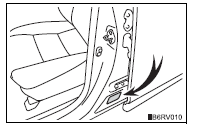
Tire types
Summer tires
Summer tires are high-speed performance tires best suited to highway driving under dry conditions. Since summer tires do not have the same traction performance as snow tires, summer tires are inadequate for driving on snow-covered or icy roads. For driving on snow-covered roads or icy roads, the use of snow tires is recommended. When installing snow tires, be sure to replace all four tires.
All season tires
All season tires are designed to provide better traction in snow and to be adequate for driving in most winter conditions as well as for use year-round. All season tires, however, do not have adequate traction performance compared with snow tires in heavy or loose snow. Also, all season tires fall short in acceleration and handling performance compared with summer tires in highway driving.
Snow tires
For driving on snow-covered roads or icy roads, we recommend using snow tires. If you need snow tires, select tires of the same size, construction and load capacity as the originally installed tires. Since your vehicle has radial tires as original equipment, make sure your snow tires also have radial construction. Do not install studded tires without first checking local regulations for possible restrictions. Snow tires should be installed on all wheels.
If the tread on snow tires wears down below 0.16 In. (4 Mm)
The effectiveness of the tires as snow tires is lost.
Situations in which the tire pressure warning system may not operate properly (if equipped)
In the following cases, the tire pressure warning system may not operate properly.
- If non-genuine toyota wheels are used.
- A tire has been replaced with a tire that is not an oe (original equipment) tire.
- A tire has been replaced with a tire that is not of the specified size.
- Tire chains etc. Are equipped.
- Lock nuts are equipped.
- An auxiliary-supported run-flat tire is equipped.
- If a window tint that affects the radio wave signals is installed.
- If there is a lot of snow or ice on the vehicle, particularly around the wheels or wheel housings.
- If the tire inflation pressure is extremely higher than the specified level.
- If the spare tire is in a location subject to poor radio wave signal reception.*
- If a large metallic object which can interfere with signal reception is put in the luggage compartment.*
*: Vehicles with a full-size spare tire only
Performance may be affected in the following situations.
- Near a tv tower, electric power plant, gas station, radio station, large display, airport or other facility that generates strong radio waves or electrical noise
- When carrying a portable radio, cellular phone, cordless phone or other wireless communication device
When the vehicle is parked, the time taken for the warning to start or go off could be extended.
When tire inflation pressure declines rapidly for example when a tire has burst, the warning may not function.
The initialization operation (vehicles with the tire pressure warning system)
Make sure to carry out initialization after adjusting the tire inflation pressure.
Also, make sure the tires are cold before carrying out initialization or tire inflation pressure adjustment.
If you have accidentally turned the engine switch to the “lock” position (vehicles without a smart key system) or off (vehicles with a smart key system) during initialization, it is not necessary to press the reset switch again as initialization will restart automatically when the engine switch has been turned to the “on” position (vehicles without a smart key system) or ignition on mode (vehicles with a smart key system) for the next time.
If you accidentally press the reset switch when initialization is not necessary, adjust the tire inflation pressure to the specified level when the tires are cold, and conduct initialization again.
When initialization of the tire pressure warning system has failed (if equipped)
Initialization can be completed in a few minutes. However, in the following cases, the settings have not been recorded and the system will not operate properly. If repeated attempts to record tire inflation pressure settings are unsuccessful, have the vehicle inspected by your toyota dealer.
When operating the tire pressure warning reset switch, the tire pressure warning light does not blink 3 times.
After driving for a certain period of time since the initialization has been completed, the warning light comes on after blinking for 1 minute.
Tire pressure warning system certification
For vehicles sold in the u.S.A.
Trw automotive
Tire pressure monitoring sensor
Fcc id: gq4-51t
This device complies with part 15 of the fcc rules. Operation is subject to the following two conditions: (1) this device may not cause harmful interference, and (2) this device must accept any interference received, including interference that may cause undesired operation of this device.
Warning: changes or modifications not expressively approved by trw automotive u.S. Llc could void the user’s authority to operate the equipment.
Fcc id: paxpmvc010
Note
This device complies with part 15 of the fcc rules. Operation is subject to the following two conditions: (1) this device may not cause harmful interference, and (2) this device must accept any interference received, including interference that may cause undesired operation.
Fcc warning
Changes or modifications not expressly approved by the party responsible for compliance could void the user’s authority to operate the equipment.
For vehicles sold in canada
Trw automotive
Tire pressure monitoring sensor
Model: 228408
Ic: 1470a-32t
Made in u.S.A.
This device complies with industry canada license-exempt rss standard( s). Operation is subject to the following two conditions: (1) this device may not cause harmful interference, and (2) this device must accept any interference received, including interference that may cause undesired operation of this device.
Le présent appareil est conforme aux cnr d’industrie canada applicables aux appareils radio exempts de licence. L’exploitation est autorisée aux deux conditions suivantes : 1. L’appareil ne doit pas produire de brouillage. 2. L’utilisateur de l’appareil doit accepter tout brouillage radioélectrique subi, même si le brouillage est susceptible d’en compromettre le fonctionnement.
Warning: changes or modifications not expressively approved by trw automotive u.S. Llc could void the user’s authority to operate the equipment.
Note
Operation is subject to the following two conditions: (1) this device may not cause interference, and (2) this device must accept any interference, including interference that may cause undesired operation of the device.
Note
L’utilisation de ce dispositif est autorisée seulement aux deux conditions suivantes : (1) il ne doit pas produire de brouillage, et (2) l’utilisateur du dispositif doit être prêt à accepter tout brouillage radioélectrique reçu, même si ce brouillage est susceptible de compromettre le fonctionnement du dispositif.
Caution
When inspecting or replacing tires
Observe the following precautions to prevent accidents.
Failure to do so may cause damage to parts of the drive train as well as dangerous handling characteristics, which may lead to an accident resulting in death or serious injury.
- Do not mix tires of different makes, models or tread patterns.
Also, do not mix tires of remarkably different treadwear.
- Do not use tire sizes other than those recommended by toyota.
- Do not mix differently constructed tires (radial, bias-belted or bias-ply tires).
- Do not mix summer, all season and snow tires.
- Do not use tires that have been used on another vehicle.
Do not use tires if you do not know how they were used previously.
- Vehicles with a compact spare tire: do not tow if your vehicle has a compact spare tire installed.
When initializing the tire pressure warning system (if equipped)
Do not operate the tire pressure warning reset switch without first adjusting the tire inflation pressure to the specified level. Otherwise, the tire pressure warning light may not come on even if the tire inflation pressure is low, or it may come on when the tire inflation pressure is actually normal.
Notice
Repairing or replacing tires, wheels, tire pressure warning valves, transmitters and tire valve caps (vehicles with the tire pressure warning system)
- When removing or fitting the wheels, tires or the tire pressure warning valves and transmitters, contact your toyota dealer as the tire pressure warning valves and transmitters may be damaged if not handled correctly.
- Make sure to install the tire valve caps. If the tire valve caps are not installed, water could enter the tire pressure warning valves and the tire pressure warning valves could be bound.
- When replacing tire valve caps, do not use tire valve caps other than those specified. The cap may become stuck.
To avoid damage to the tire pressure warning valves and transmitters (vehicles with the tire pressure warning system)
When a tire is repaired with liquid sealants, the tire pressure warning valve and transmitter may not operate properly. If a liquid sealant is used, contact your toyota dealer or other qualified service shop as soon as possible. Make sure to replace the tire pressure warning valve and transmitter when replacing the tire.
Driving on rough roads
Take particular care when driving on roads with loose surfaces or potholes.
These conditions may cause losses in tire inflation pressure, reducing the cushioning ability of the tires. In addition, driving on rough roads may cause damage to the tires themselves, as well as the vehicle’s wheels and body.
If tire inflation pressure of each tire becomes low while driving
Do not continue driving, or your tires and/or wheels may be ruined.
 Engine compartment
Engine compartment
Engine coolant reservoir
Engine oil filler cap
Battery
Brake fluid reservoir
Fuse box
Radiator
Condenser
Electric cooling fans
Engine oil level dipstick
Washer fluid tank
E ...
 Tire inflation pressure
Tire inflation pressure
Tire inflation pressure
The recommended cold tire inflation
pressure and tire size are displayed
on the tire and loading
information label.
Inspection and adjustment procedure
Tire valve
...
Other materials:
Evaporative emission system switching valve control
Dtc summary
Hint:
The vent valve is built into the canister pump module.
Description
The description can be found in the evap (evaporative emission) system (see
page es-335).
Inspection procedure
Refer to the evap system (see page es-340).
Monitor description
5 Hours* after the ign ...
Fuel pump control circuit
Description
When the engine is cranked, the starter relay drive signal output from the
star terminal of the ecm is
input into the sta terminal of the ecm, and ne signal generated by the
crankshaft position sensor is also
input into the ne+ terminal. Thus, the ecm interprets that the engine is ...
Vehicle load limits
Vehicle load limits include total load capacity, seating capacity,
twr (trailer weight rating) and cargo capacity.
Total load capacity (vehicle capacity weight)
Total load capacity means the combined weight of occupants, cargo
and luggage.
Seating capacity: 5 occupants (front 2, rear 3)
Seatin ...
